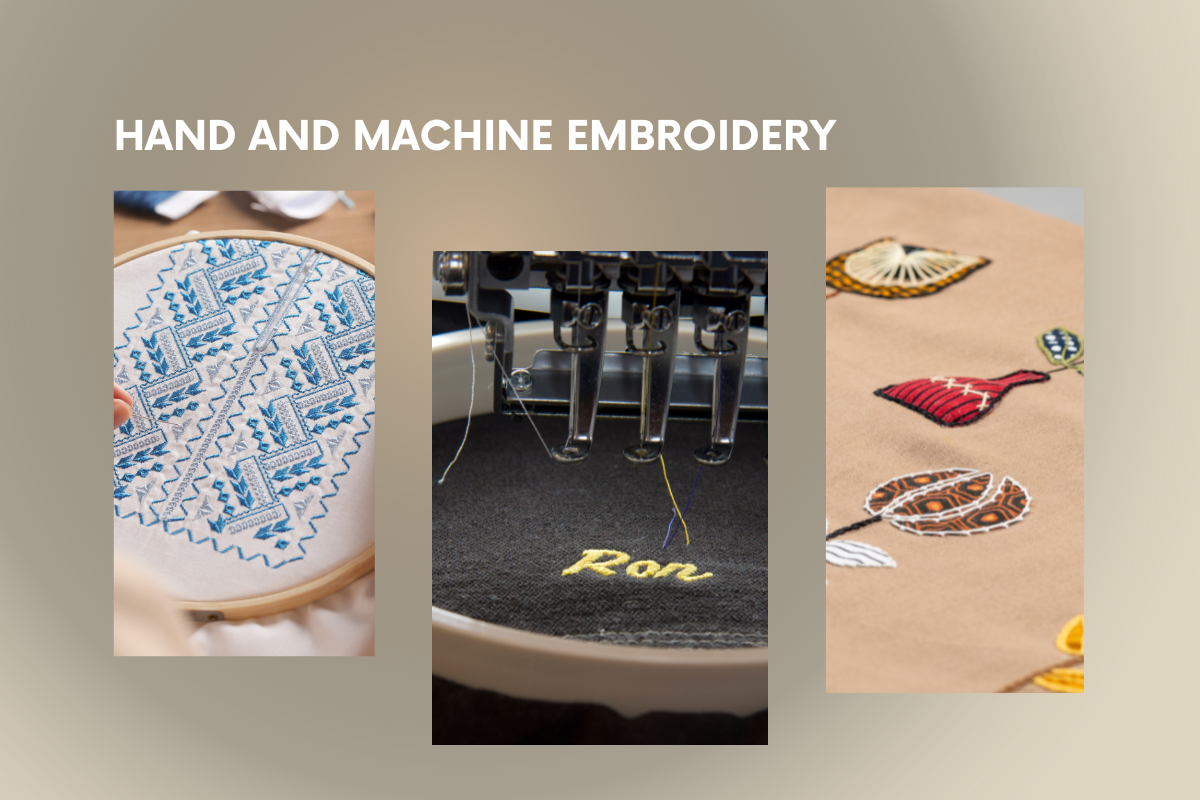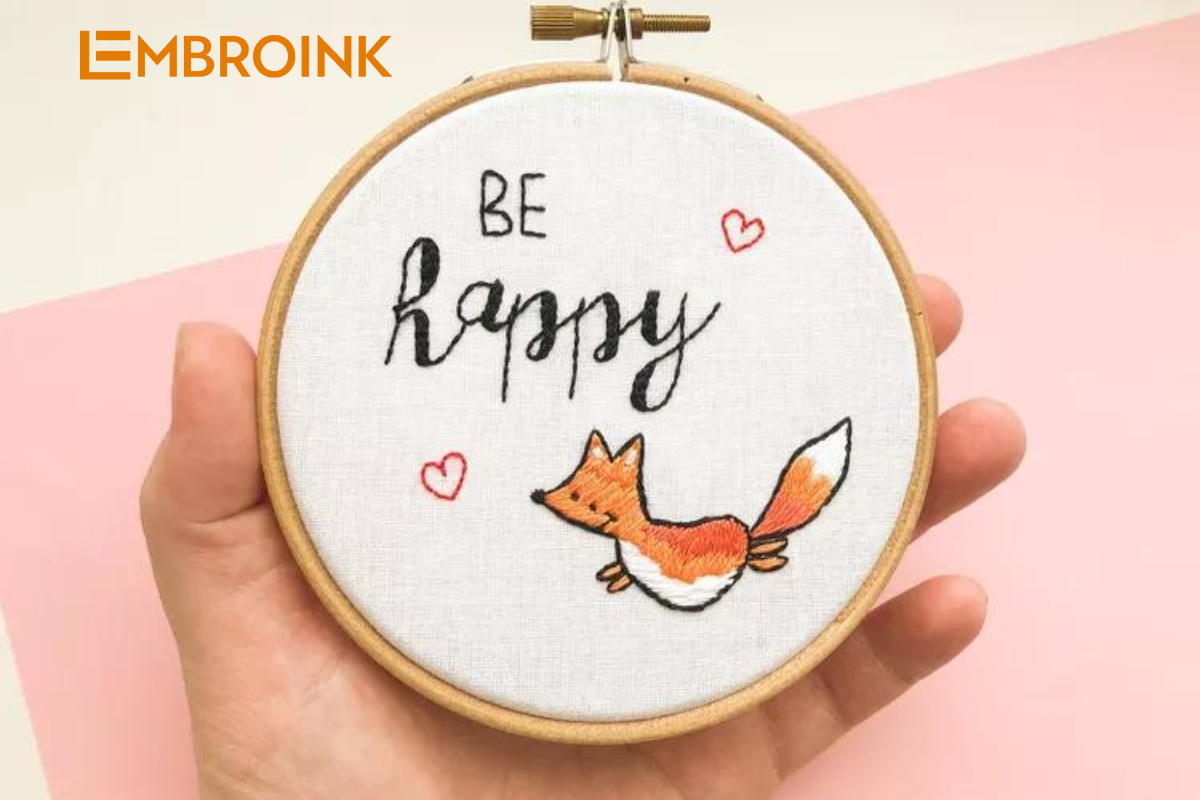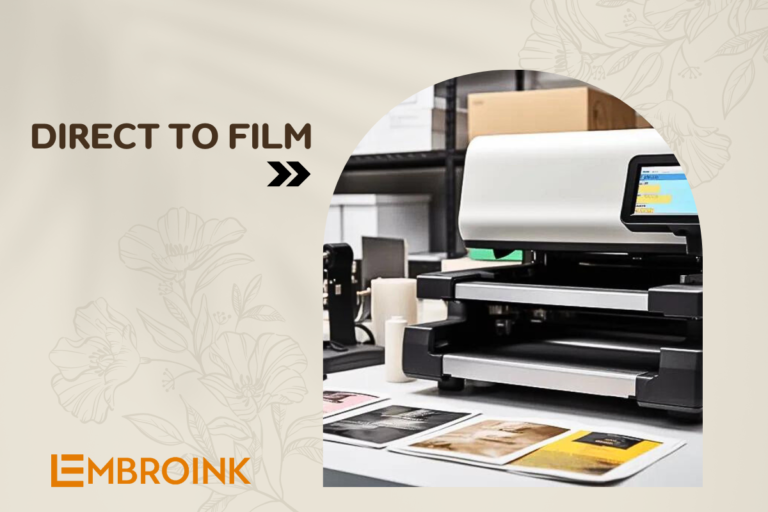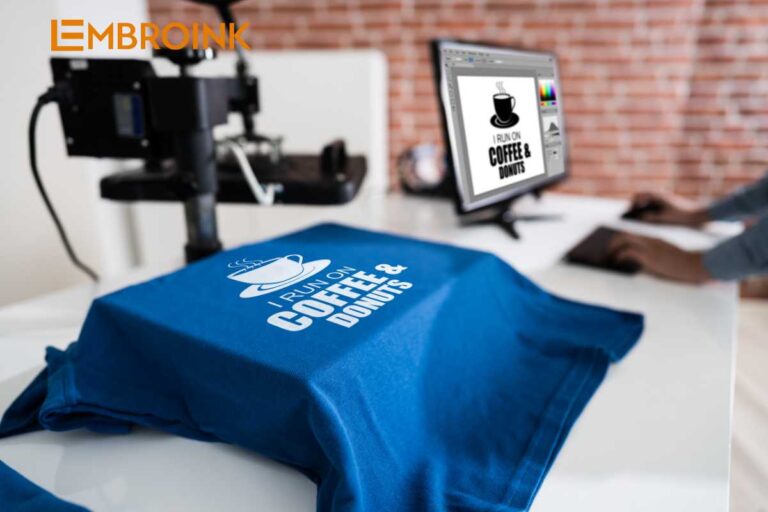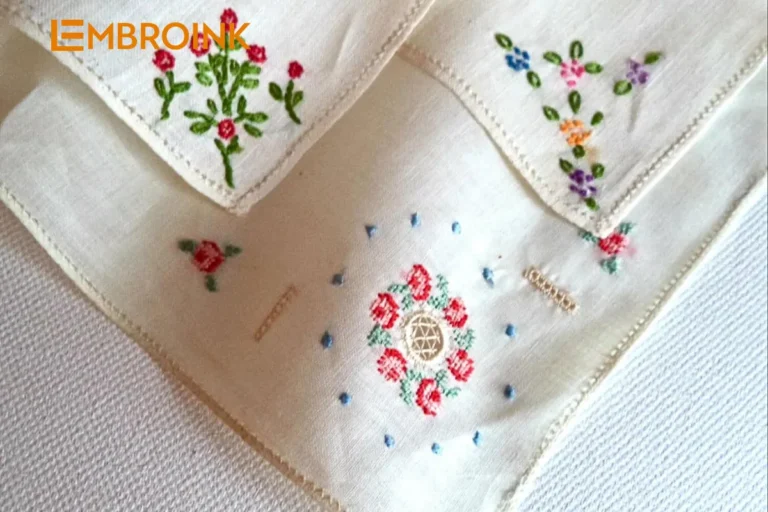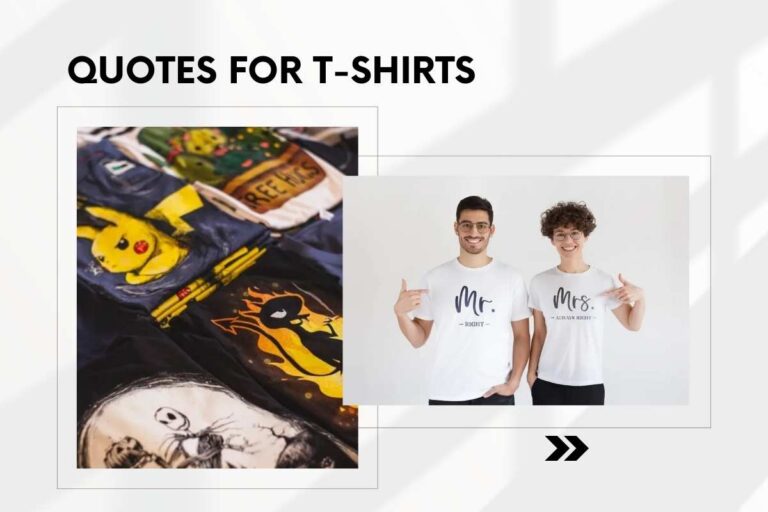Hand and Machine Embroidery: What’s The Difference?
You can opt for either hand embroidery or machine embroidery, but beyond the obvious, what sets these two techniques apart? Let’s explore with EmbroInk what makes each method unique and why you might prefer one over the other.
Both hand and machine embroidery involve decorating fabric (and sometimes other materials) with thread to create designs ranging from simple initials or monograms to intricate wall hangings or fully embroidered garments. While they share tools like hoops, needles, and threads, the processes and outcomes differ significantly, even when the finished pieces appear alike.
Hand Embroidery
Hand embroidery is known for its slow, meticulous process, with each stitch being crafted individually. While the time investment can be seen as a drawback, many find it to be a calming and meditative activity.
Due to the time and effort involved, hand-embroidered pieces are often considered more valuable, with a sense of heirloom quality. Hand embroidery offers great flexibility, allowing you to adjust colors and stitches as you go, giving you creative control over your project.
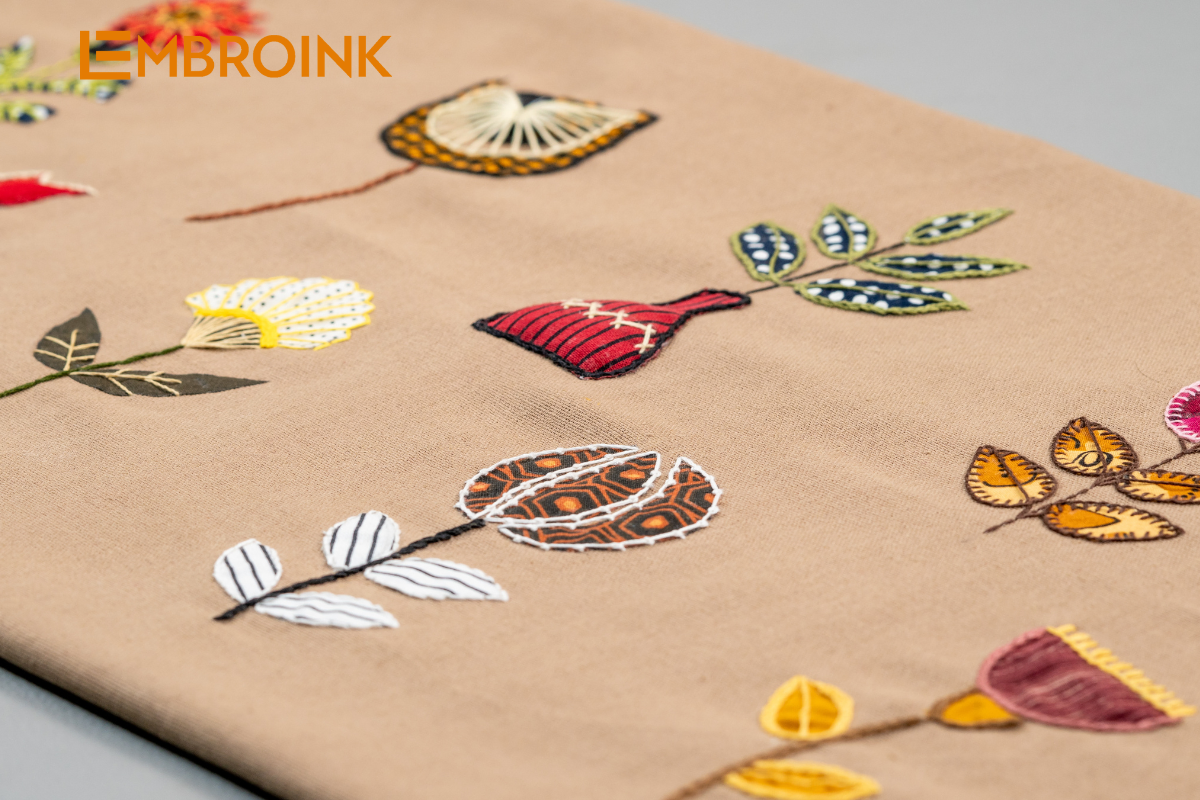
Getting Started
Though starting hand embroidery may seem intimidating at first, it is, in fact, a highly accessible and affordable craft that anyone can enjoy. The basic materials required are simple and readily available, including fabric, thread, and a needle, making it easy to gather everything you need to get started. There’s no need for expensive equipment or specialized tools—just a few fundamental supplies will do.
Moreover, the learning curve is quite gentle, as you only need to master a handful of basic techniques to begin creating beautiful pieces. This simplicity opens the door for people of all ages to participate; even children can easily pick up hand embroidery, fostering creativity and fine motor skills in a fun, engaging way. As you embark on this artistic journey, the joy of producing something with your own hands is incredibly rewarding. Each completed project serves as a personal testament to your effort and creativity, resulting in unique, handcrafted items that carry a special significance. Whether you’re making a simple embroidered gift, a decorative piece for your home, or just exploring your artistic side, hand embroidery provides a fulfilling outlet for self-expression and creativity.
Types of Thread
Stitches
Hand embroidery provides an extensive array of stitch options, each contributing its own unique texture and style to your creations. Whether you’re looking to create simple lines or fill larger areas, the variety of stitches available allows for incredible versatility in your designs. For instance, you can use running stitches for delicate outlines, satin stitches for smooth, filled areas, or chain stitches for decorative borders.
Moreover, hand embroidery enables you to craft intricate shapes, such as flowers, leaves, and geometric patterns, each achievable through various stitching techniques. This diversity makes the craft a highly creative outlet, encouraging you to experiment and explore different combinations. You can play with color, stitch density, and design complexity, making every project an opportunity to express your artistic vision. Whether you’re a beginner or an experienced embroiderer, the countless stitch options inspire creativity and allow for endless possibilities, transforming your fabric into a canvas of personal expression
Patterns
Patterns for hand embroidery are available in a variety of formats, catering to different preferences and skill levels. One popular option is iron-on transfers, which allow you to easily press a design onto your fabric, creating a clear guide to follow as you stitch. This method is particularly convenient for beginners who want a straightforward way to start their projects without worrying about drawing or tracing designs by hand.
In addition to iron-on transfers, patterns can also be found in embroidery books, where a wealth of designs and ideas await. Many of these books provide step-by-step instructions and helpful tips, making them excellent resources for both novice and experienced embroiderers. Alternatively, digital files are becoming increasingly popular, allowing you to print your desired patterns at home. These files can be transferred to fabric using various methods, such as tracing with a lightbox or using a transfer pen, giving you the flexibility to choose the technique that works best for you.
The availability of patterns ranges from free options to affordable designs, ensuring that you can find plenty of inspiration for your next project without breaking the bank. Whether you’re looking for intricate floral designs, whimsical motifs, or classic monograms, there’s an abundance of patterns out there to ignite your creativity and help you bring your embroidery visions to life.
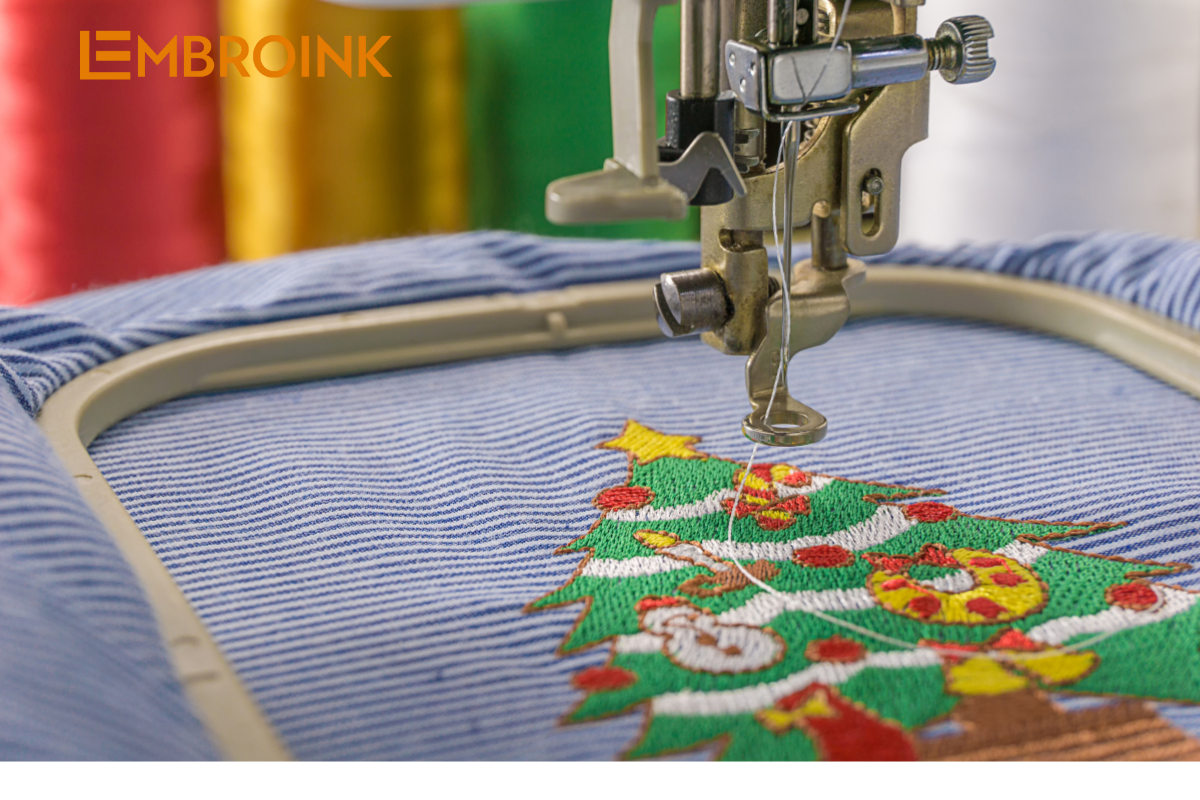
Machine Embroidery
Machine embroidery offers a faster, more automated process compared to hand embroidery. Once set up, the machine often handles the work for you, making it an excellent option for those who enjoy crafting but may have difficulty with the manual aspects of hand embroidery. The final product tends to have a more polished, commercial appearance.
If you’re producing multiple items with the same design, machine embroidery ensures consistency, as each piece will look nearly identical. However, most patterns are pre-programmed, limiting your ability to customize the designs on the fly.
Getting Started
In addition to traditional machine embroidery, you can also explore free-motion embroidery using a regular sewing machine with the feed dogs lowered. This innovative method allows you to mimic the freedom and creativity of hand embroidery, enabling you to “draw” intricate designs directly onto your fabric with your sewing machine. By controlling the movement of the fabric under the needle, you can create unique patterns and textures that resemble hand-stitched work, giving you a new level of artistic expression.
Investing in a sewing machine, particularly one designed for embroidery, can be a significant financial commitment. Beyond the initial cost of the machine itself, you’ll also need to consider additional expenses for patterns, threads, and various accessories. This makes it essential to approach this craft with a clear understanding of the investment involved. However, the rewards can be substantial; once you’ve mastered your machine, the potential for creating beautiful, professional-looking embroidered pieces is nearly limitless.
Learning to operate an embroidery machine requires familiarizing yourself with its various functions and how it interacts with different materials, which can be a bit overwhelming at first. Unlike hand embroidery, where you need to acquire stitching techniques, machine embroidery focuses more on understanding your equipment. If you choose to dive into free-motion embroidery, however, be prepared for a learning curve as this technique requires practice to master, combining machine operation with the artistry of freehand design. Overall, whether you’re looking to create intricate patterns or simply enjoy the process, machine embroidery can be an exciting and fulfilling avenue to explore.
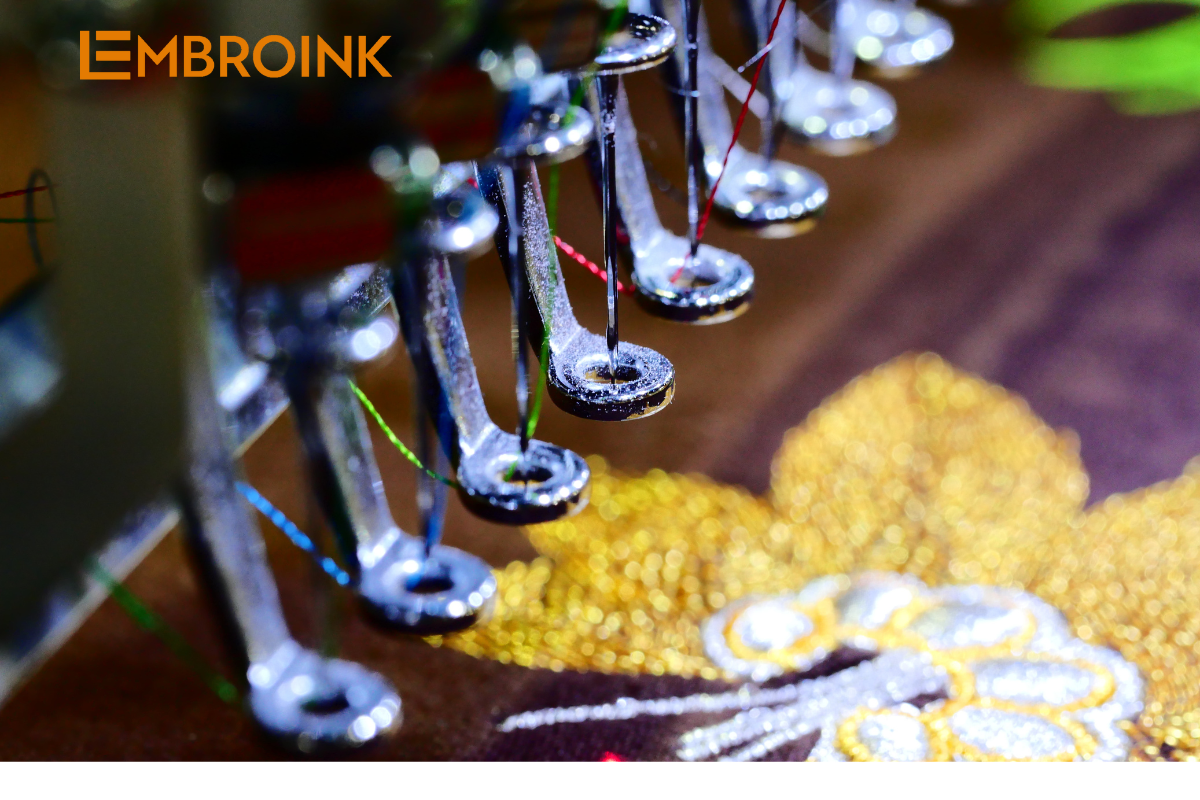
Types of Thread
Machine embroidery thread is typically sold on spools, designed for immediate use without the option to separate strands like hand embroidery thread. This means you work with the thread as it comes, which can streamline the embroidery process and reduce preparation time. However, the threads are available in a range of weights, allowing you to select the right thickness to achieve your desired look and finish.
Depending on the aesthetic you’re aiming for, you have various materials to choose from, including polyester, cotton, rayon, and silk. Polyester thread is known for its durability and resistance to fading, making it a popular choice for items that will undergo frequent washing or wear. Cotton thread, on the other hand, offers a natural feel and is great for achieving a classic, matte finish. Rayon is celebrated for its vibrant colors and lustrous sheen, adding a touch of elegance to your projects, while silk thread provides a luxurious finish that can elevate the overall appearance of your embroidery.
The variety of thread options not only enhances the visual appeal of your designs but also influences the texture and feel of the finished piece. By selecting the right material and weight, you can customize your machine embroidery to suit your style and the specific requirements of each project, ensuring that every piece stands out in its own unique way.
Stitches
Machine embroidery is capable of replicating a wide range of traditional hand stitches, including satin stitch, long and short stitch, back stitch, and chain stitch. This variety of stitch types allows for a high level of detail and texture in your designs, bringing your creative visions to life with precision and ease.
Satin stitch is often used to create smooth, filled areas, adding a polished look to letters and motifs. The long and short stitch technique is perfect for achieving shading and dimension, allowing you to mimic the natural look of flowers or other organic shapes. Back stitch offers a classic outline effect, providing structure to your designs, while chain stitch adds a decorative touch, enhancing borders and giving a playful flair.
The ability to switch between these stitches seamlessly means that you can create intricate and textured patterns that closely resemble hand-stitched work. This versatility not only expands your design possibilities but also streamlines the embroidery process, enabling you to produce high-quality, professional-looking results in a fraction of the time it would take to hand embroider each stitch. With machine embroidery, you can explore a world of creativity, combining various stitch types to produce unique and visually stunning pieces.
Patterns
Patterns for machine embroidery are primarily available as digital files that you can easily load directly into your embroidery machine. It’s important to note that each brand of embroidery machine uses specific file formats, so ensuring compatibility is crucial for a smooth stitching experience.
These digital patterns typically indicate the number of stitches involved in the design, providing a helpful estimate of how long it will take to complete based on your machine’s speed settings. This feature allows you to plan your embroidery projects more effectively, especially if you’re working on larger or more intricate designs.
Pricing for pattern files varies significantly, reflecting the complexity and detail of the design. You can find many free options online, while others may cost a few dollars. Some collections, particularly those featuring extensive designs or themes, can reach $50 or more. Additionally, many embroidery machines come pre-loaded with patterns that allow for creative combinations, such as merging embroidery with appliqué, lacework, or other DIY sewing projects. These are often referred to as “in the hoop” projects, where the entire process, including cutting and stitching, is completed within the embroidery hoop. This integration opens up exciting possibilities for your creations, enhancing the versatility and enjoyment of machine embroidery.

Hand and Machine Embroidery: Which is Best?
There is no definitive answer to which embroidery method is superior; the choice largely hinges on your personal preferences and specific needs. Some crafters find immense joy in the meditative and deliberate process of hand embroidery, where each stitch allows for creative expression and a connection to the materials. This method can be incredibly fulfilling, offering a sense of accomplishment as you watch your design come to life one stitch at a time.
On the other hand, you may prefer the speed and precision that machine embroidery offers. With the ability to quickly replicate designs and achieve professional-quality results, machine embroidery can be especially appealing for larger projects or when producing multiple items. The efficiency of this method can free up your time for other creative pursuits or allow you to take on more ambitious projects.
Alternatively, you might consider learning both techniques, which opens up a world of possibilities for your crafting endeavors. By mastering hand and machine embroidery, you can create truly unique pieces that combine the personal touch of hand-stitching with the polished finish of machine work. This dual approach allows you to enjoy the distinct benefits of each method, enhancing your overall embroidery experience and expanding your creative repertoire. Ultimately, the best choice is the one that resonates with you and aligns with your artistic goals.

